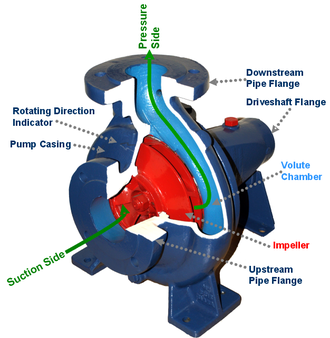Centrifugal pump
==Centrifugal Pump ==
A centrifugal pump is a mechanical device designed to move fluids by the transfer of rotational energy from one or more driven rotors, called impellers. The fluid enters the rapidly rotating impeller along its axis and is cast out by centrifugal force along its circumference through the impeller's vane tips. The action of the impeller increases the fluid's velocity and pressure and directs it towards the pump outlet.
History
The concept of centrifugal pumps dates back to the late 17th century, with the first true centrifugal pump being developed by Denis Papin in 1689. Over the centuries, advancements in engineering and materials science have significantly improved the efficiency and reliability of these pumps.
Components
A centrifugal pump typically consists of the following main components:
- Impeller: The rotating part that transfers energy to the fluid.
- Casing: The outer shell that contains the fluid and directs it through the pump.
- Suction and Discharge Nozzles: The points where the fluid enters and exits the pump.
- Shaft: The component that transmits the rotational energy from the motor to the impeller.
- Bearing: Supports the shaft and reduces friction.
- Seal: Prevents the fluid from leaking out of the pump.
Working Principle
The working principle of a centrifugal pump is based on the conversion of kinetic energy to hydraulic energy (pressure). The fluid enters the pump impeller along or near to the rotating axis and is accelerated by the impeller, flowing radially outward into a diffuser or volute chamber (casing), from where it exits into the downstream piping system.
Types of Centrifugal Pumps
Centrifugal pumps can be classified based on several criteria:
- Number of impellers: Single-stage and multi-stage.
- Suction type: Single-suction and double-suction.
- Casing design: Volute and diffuser.
- Orientation: Horizontal and vertical.
Applications
Centrifugal pumps are widely used in various industries due to their versatility and efficiency. Common applications include:
- Water supply and irrigation
- Chemical processing
- Petroleum and oil refining
- Food and beverage production
- HVAC systems
- Wastewater treatment
Advantages and Disadvantages
Advantages
- Simple design and easy maintenance
- High efficiency for low-viscosity fluids
- Capable of handling large volumes of fluid
- Smooth and continuous flow
Disadvantages
- Not suitable for high-viscosity fluids
- Performance can be affected by changes in fluid density and viscosity
- Requires priming to start
Maintenance
Regular maintenance of centrifugal pumps is crucial to ensure their longevity and efficient operation. Maintenance tasks include:
- Inspecting and replacing worn impellers and seals
- Lubricating bearings
- Checking for leaks and unusual noises
- Ensuring proper alignment of the pump and motor
See Also
References
External Links
Transform your life with W8MD's budget GLP-1 injections from $125.
W8MD offers a medical weight loss program to lose weight in Philadelphia. Our physician-supervised medical weight loss provides:
- Most insurances accepted or discounted self-pay rates. We will obtain insurance prior authorizations if needed.
- Generic GLP1 weight loss injections from $125 for the starting dose.
- Also offer prescription weight loss medications including Phentermine, Qsymia, Diethylpropion, Contrave etc.
NYC weight loss doctor appointments
Start your NYC weight loss journey today at our NYC medical weight loss and Philadelphia medical weight loss clinics.
- Call 718-946-5500 to lose weight in NYC or for medical weight loss in Philadelphia 215-676-2334.
- Tags:NYC medical weight loss, Philadelphia lose weight Zepbound NYC, Budget GLP1 weight loss injections, Wegovy Philadelphia, Wegovy NYC, Philadelphia medical weight loss, Brookly weight loss and Wegovy NYC
|
WikiMD's Wellness Encyclopedia |
| Let Food Be Thy Medicine Medicine Thy Food - Hippocrates |
Medical Disclaimer: WikiMD is not a substitute for professional medical advice. The information on WikiMD is provided as an information resource only, may be incorrect, outdated or misleading, and is not to be used or relied on for any diagnostic or treatment purposes. Please consult your health care provider before making any healthcare decisions or for guidance about a specific medical condition. WikiMD expressly disclaims responsibility, and shall have no liability, for any damages, loss, injury, or liability whatsoever suffered as a result of your reliance on the information contained in this site. By visiting this site you agree to the foregoing terms and conditions, which may from time to time be changed or supplemented by WikiMD. If you do not agree to the foregoing terms and conditions, you should not enter or use this site. See full disclaimer.
Credits:Most images are courtesy of Wikimedia commons, and templates, categories Wikipedia, licensed under CC BY SA or similar.
Contributors: Prab R. Tumpati, MD




